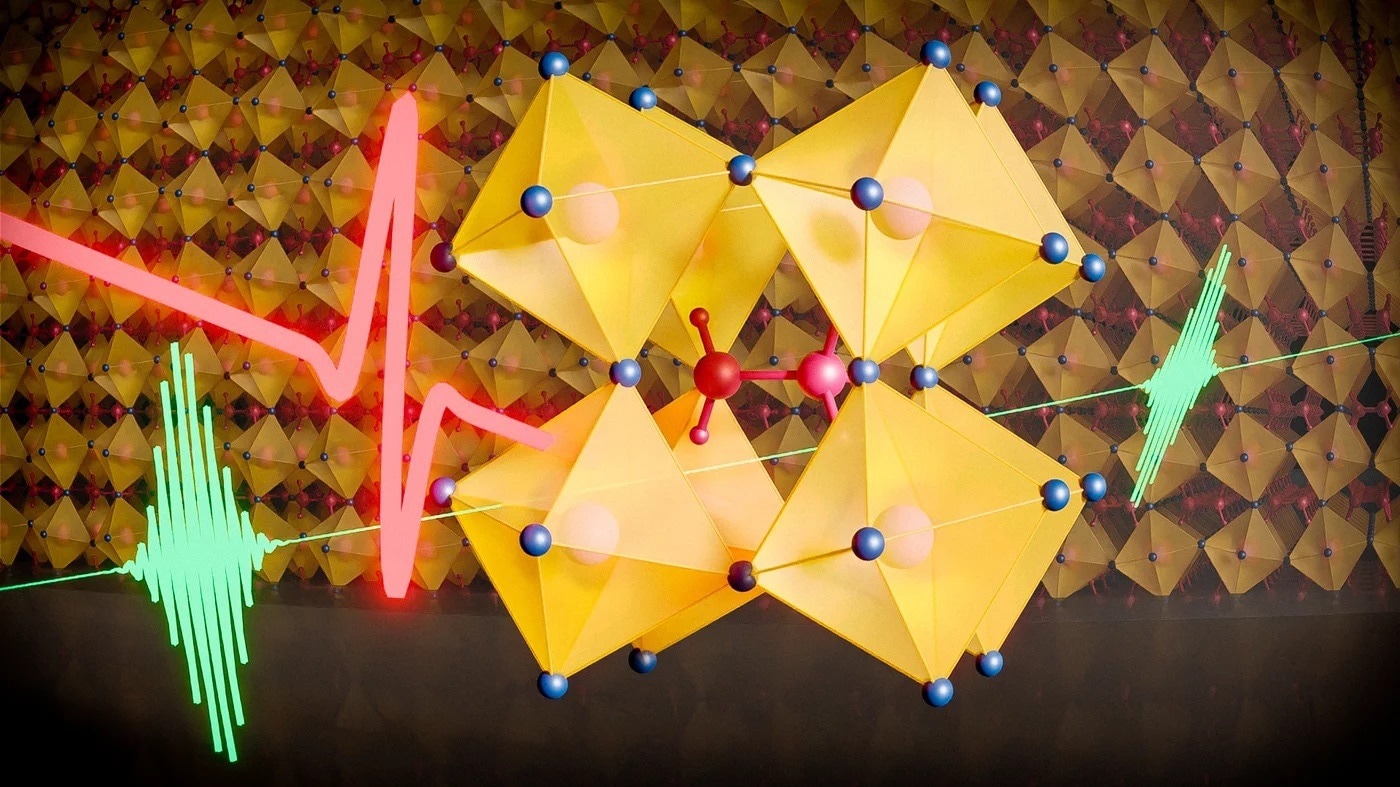To win over global energy difficulties and combat the forthcoming environmental crisis, scientists across the world analyze new materials for transforming sunlight into electricity. A few of the most potential applicants for high-efficiency low-cost solar cell applications are founded on lead halide perovskite (LHP) semiconductors.
 A single cycle of intense Terahertz laser light (red) rapidly twists the atomic lattice of a hybrid organic-inorganic solar cell material. The resulting ultrafast shaking of the lead halide lattice is traced by stroboscopic snapshots using visible laser pulses (green). The observed lattice response provides novel insights into microscopic mechanisms for protecting electric charges and paves the way for ultrafast control of the material’s optoelectronic properties. Image Credit: Maximilian Frenzel, FHI
A single cycle of intense Terahertz laser light (red) rapidly twists the atomic lattice of a hybrid organic-inorganic solar cell material. The resulting ultrafast shaking of the lead halide lattice is traced by stroboscopic snapshots using visible laser pulses (green). The observed lattice response provides novel insights into microscopic mechanisms for protecting electric charges and paves the way for ultrafast control of the material’s optoelectronic properties. Image Credit: Maximilian Frenzel, FHI
Despite record-breaking solar cell prototypes, the microscopic origin of the remarkably outstanding optoelectronic performance of this material class is not yet understood completely. At present, a global team of physicists and chemists from Fritz Haber Institute of the Max Planck Society, École Polytechnique in Paris, Columbia University in New York, and the Free University in Berlin established laser-driven control of essential motions of the LHP atomic lattice.
By giving an impulsive electric field spike more rapidly than a trillionth of a second (picosecond) in the form of a single light cycle of far-infrared Terahertz radiation, the researchers showed the ultrafast lattice response, which might add up to a dynamic protection mechanism for electric charges. This accurate control over the atomic twist motions will facilitate the formation of new non-equilibrium material properties, possibly offering signs for developing the solar cell material of the future.
The investigated hybrid LHP solar cell materials comprise an inorganic crystal lattice, which functions as periodic cages for hosting organic molecules. The determination of how much electricity can be extracted from the sunlight’s energy is done by the interplay of free electronic charges with this hybrid lattice and its impurities. Comprehending this complicated communication may be the key to a microscopic understanding of the LHPs’ excellent optoelectronic performance.
Scientists from Fritz Haber Institute in Berlin and their international co-workers could now isolate the lattice response to an electric field on timescales quicker than 100 femtoseconds, which is one-tenth of a trillionth of a second. A strong laser pulse comprising just a single cycle of far-infrared, alleged Terahertz (THz), light applies the electric field.
This THz field is so strong and so fast that it may mimic the local electric field of an excited charge carrier immediately after the absorption of a quantum of sunlight.
Maximilian Frenzel, Study Main Author, Fritz Haber Institute of the Max Planck Society
Through this technique, the investigators notice an intensive motion of the crystal lattice, mainly comprising the back-and-forth tilting of the octahedral building blocks of the inorganic cage. Such nonlinearly excited vibrations can result in—so far ignored—higher order screening effects, adding up to an often argued charge carrier protection mechanism.
Moreover, the related tilting angle plays a dominating role in determining the fundamental material properties, such as the crystallographic phase or electronic bandgap.
Dr. Sebastian Maehrlein, International Research Project Leader, Fritz Haber Institute of the Max Planck Society
Hence, rather than static chemical tuning of material properties, ultrafast dynamic material design paves the way. “As we can now modulate these twist angles by a single THz light cycle. In future we might be able to control material properties on demand or even discover novel exotic states of this emerging material class,” concludes Dr Maehrlein. By examining those dynamic states of matter, scientists believe in adding up certain hints for developing the energy materials of the future.
Journal Reference:
Frenzel, M., et al. (2023). Nonlinear terahertz control of the lead halide perovskite lattice. Science Advances. https://doi.org/10.1126/sciadv.adg3856.